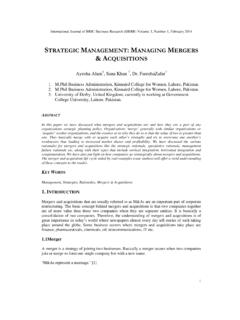Transcription of 6. A guide to Mergers and Acquisitions in the UK
1 6. A guide to Mergers and Acquisitions in the UK. Mergers & Acquisitions (M&A) are becoming increasingly popular for the aspiring foreign company wanting to invest in the UK. Business growth can be achieved in a variety of ways. Organic expansion through marketing and business development is perhaps the most conventional option, but it may not be the fastest. In addition, growing organically in overseas markets is challenging where local customs, rules and regulations are not fully understood. One, often quicker option, that can avoid the challenges of setting up in a new market, is to either invest in, or buy outright, a business operating in the market of interest.
2 Today, Acquisitions of Western businesses by overseas (buyers are at an all time high, and levels are growing. Foreign companies may undertake M&A for a variety of reasons, including obtaining brands and intellectual property, market access, and market knowledge. Foreign companies are becoming increasingly confident in their ability to finance and execute deals. And foreign private equity acquirers, those who buy in to a company primarily as an investment rather than as an addition to their existing business, are becoming more established.)
3 Despite the growing volume and value of deals, M&A transactions are not without risks, and proper advice should be sought when contemplating this option. This chapter sets out some of the key considerations. In each of these areas, Deloitte has a specialist team available to assist. M&A strategy In considering whether M&A is the appropriate method to improve shareholder value, performance and market competitiveness, a company should first review its corporate strategy. corporate strategy makes the company greater than the sum of its business units, and sets out the organisation's direction and goals, business portfolio, resource allocation and growth plans.
4 A corporate strategy review is critical for success, yet is often neglected by executives under pressure to achieve short term results. One of the primary causes for acquisition failures is a lack of insight into the target company, its core competencies and limitations, and changing market conditions. The rigorous analysis conducted in a strategy review enables a company to understand its internal strengths and external market conditions, both in its home country and overseas, over the coming few years. This analysis helps to develop a set of prioritised options, such as an acquisition or divestment, to achieve its objectives.
5 Investing in the UK A guide for South African businesses 55. As challenges and opportunities for growth are defined, options to defend, grow, fix or exit can be assessed and prioritised based on the company's goals, capabilities and financial position. Generally, companies can choose from a myriad of strategic objectives such as: profitable growth to increase business breadth or depth through revenue growth, market share capture, margin enhancement or improved asset utilisation;. skill strengthening to acquire the necessary talent to remain competitive ( personnel, technology, capability, geographies, etc.)
6 ;. portfolio management to manage a portfolio of businesses in order to maximise existing and evolving capabilities, reduce risk, or reposition a business;. defensive action to ward off potential take-over attempts or fix existing business/operational problems;. opportunistic posture to capitalise on a unique market/competitive opportunity or a developing business formula; and globalisation to expand market share and sales in international venues. Depending on a company's strategy, Acquisitions may serve as a way to quickly achieve strategic and financial objectives.
7 Target sourcing and selection Once the company has determined that an acquisition fits with its wider corporate strategy, the next phase is to identify potential targets, synergy opportunities and to arrive at a valuation. Developing a pool of targets In assessing investment opportunities, a company should evaluate the attractiveness of the sector in which it plans to conduct an acquisition by: nnderstanding the industry structure and leverage points, where value can be captured;. appreciating the market scale, and growth potentials.
8 Understanding the key players, both domestic and foreign-owned, along with competitive dynamics;. envisaging any technological trend; and identifying entry barriers. Once the decision is made to pursue opportunities in a sector, the company can begin its preliminary research on potential acquisition candidates. Investing in the UK A guide for South African businesses 56. Developing the acquisition candidate pool The first step in a target selection process is to develop a long list of potential acquisition candidates.
9 This involves a high-level search based on criteria such as: Sector/industry. Competitive position within the industry/product mix. Revenue/size. Market capitalisation. Location of operations. Often a search will come up with more than 100 potential candidates in the long list. These potential candidates will be further screened and profiled. Sourcing potential acquisition candidates Finding the right candidate, a buyer or a seller, requires time and patience. A search for a target requires an extensive review of potential candidates before finding one that fits a company's strategic needs, whilst being fairly priced.
10 A company could identify potential acquisition targets by conducting internal analysis or using its own network. Some business owners would search openly for a buyer whilst others would identify potential candidates through: examining the financial position of potential companies. Financial problems such as cash shortages or excessive debt may indicate that a sale may be necessary; and investigating the potential company's shareholding and management. Indications of possible future sales include an owner nearing retirement with no heirs in key management positions, absentee owners, or financial investors potentially interested in an exit strategy.












